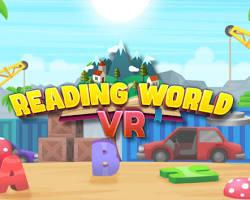การเกิดขึ้นของเกม VR ที่เหมาะกับเด็กได้นำโอกาสมากมายมาสู่การเติบโตและการเรียนรู้ให้กับเด็กๆ VR (ความเป็นจริงเสมือน) ช่วยให้ผู้ใช้โต้ตอบกับสภาพแวดล้อมใหม่และน่าตื่นเต้น เรียนรู้ในรูปแบบจำลอง และโต้ตอบกับสิ่งมีชีวิตดิจิทัลเพื่อความสนุกสนาน ซึ่งหมายถึงการค้นพบความลึกของมหาสมุทรที่ลึกที่สุด การเดินทางย้อนเวลา หรือแม้แต่เข้าสู่อาณาจักรมหัศจรรย์ และอื่นๆ อีกมากมาย นี่คือพลังแฟนตาซีของเกม VR สำหรับเด็กในปัจจุบัน! อย่างไรก็ตาม การมีส่วนร่วมของผู้ปกครองยังคงเป็นสิ่งสำคัญมากในการดูแลให้เด็กๆ ใช้ VR เพื่อการศึกษาและสันทนาการในลักษณะที่ปลอดภัย
อายุเท่าไหร่จึงจะเหมาะกับเกม VR?
ตามหลักเกณฑ์ผลิตภัณฑ์ ชุดหูฟัง VR หลายรุ่นไม่ได้ออกแบบมาสำหรับเด็กอายุต่ำกว่า 13 ปี อย่างไรก็ตาม ด้วยหลักเกณฑ์ที่ถูกต้องสำหรับผู้ปกครอง เด็กที่มีอายุต่ำกว่าช่องว่างอายุที่แนะนำยังสามารถเพลิดเพลินกับเกม VR สำหรับเด็กได้อย่างปลอดภัย
ตัวอย่างเช่น เด็กๆ ควรยอมรับกฎ 20-20-29 เมื่อใช้ VR หรือหน้าจออื่นๆ กฎระบุว่าคุณต้องหยุดพัก 20 วินาทีหลังจากทุกๆ 20 นาทีบนหน้าจอเพื่อมองวัตถุที่อยู่ห่างออกไป 20 ฟุต ข้อควรพิจารณาอื่นๆ ที่คุณสามารถทำได้ก่อนอนุญาตให้บุตรหลานใช้ VR ได้แก่:
ระดับวุฒิภาวะของลูกคุณ เด็กสามารถแยกความแตกต่างระหว่างความเป็นจริงกับ VR ได้หรือไม่?
- การพัฒนาทางกายภาพ ชุดหูฟังสำหรับเด็กของคุณสวมใส่สบายแค่ไหน? อายุขั้นต่ำที่แนะนำสำหรับชุดหูฟัง VR ส่วนใหญ่คือ 13 ปี
- ชนิดของเนื้อหา. เกม VR มีความเหมาะสมกับวัย เช่น ไม่มีฉากที่น่ากลัวหรือรุนแรงหรือไม่
- ตรวจสอบว่าชุดหูฟัง VR รองรับมาตรการควบคุมโดยผู้ปกครองหรือไม่ ซึ่งมีความสำคัญอย่างยิ่งต่อการจัดการประสบการณ์การเล่นเกม VRG ของบุตรหลานของคุณ
- การตั้งค่ามาตรการควบคุมโดยผู้ปกครองช่วยให้:
- ชุด การจำกัดเวลาหน้าจอ.
- ตั้งค่าการจำกัดอายุการเข้าถึง
- ปิดกั้นการเข้าถึง เนื้อหาที่ไม่เหมาะสมหมู่คนอื่น ๆ
ตักเตือนกันไว้ดีกว่า! แม้กระทั่งสำหรับวัยรุ่นของคุณ ให้จำกัดเซสชัน VR และกระตุ้นให้หยุดพักเพื่อหลีกเลี่ยงอาการวิงเวียนศีรษะและปวดตา
เด็กอายุ 7 ขวบเล่นเกม VR ได้ไหม?
ใช่ เด็กอายุ 7 ปีสามารถลองเล่นเกม VR สำหรับเด็กได้ แม้ว่าอายุที่แนะนำคือ 13 ปีขึ้นไปก็ตาม อย่างไรก็ตาม หากบุตรหลานของคุณสนใจเกม VR สำหรับเด็กเป็นอย่างมาก ต่อไปนี้คือสิ่งที่คุณสามารถทำได้ก่อนปล่อยให้พวกเขาลองใช้ VR
- เล่นเกมให้สั้นภายใน 10-15 นาที สายตาของเด็กยังพัฒนาอยู่และเปิดรับแสงมากเกินไป เวลาอยู่หน้าจอ และ VR อาจส่งผลให้ปวดตาอย่างไม่พึงประสงค์ได้
- เลือกเกมที่เหมาะสมกับวัย สัมผัสประสบการณ์ VR ที่ออกแบบมาสำหรับเด็กโดยเฉพาะโดยไม่มีธีมที่น่ากลัวหรือความรุนแรง
- การดูแลอย่างใกล้ชิด. ปรากฏตัวเมื่อพวกเขาเล่นและให้แน่ใจว่าร่างกายสบายตัว เตรียมพร้อมที่จะถอดชุดหูฟังหากเริ่มมีอาการไม่สบายหรือมึนงง
เด็กควรเล่น VR นานแค่ไหน?
แม้ว่าจะไม่มีเกม VR สำหรับเด็กขนาดเดียว แต่ผู้เชี่ยวชาญส่วนใหญ่แนะนำให้เล่นเกมนี้ให้สั้นและพักช่วงสั้นๆ ระหว่างเกม
การจัดการเวลาอยู่หน้าจอ แนะนำให้ทำครั้งละ 10-15 นาทีสำหรับเด็กส่วนใหญ่ ช่วยเหลือ ให้พวกเขาเพลิดเพลินกับเกม VR โดยไม่เสี่ยงต่ออาการวิงเวียนศีรษะหรือปวดตา
พักช่วงสั้น ๆ ทุกๆ 20 นาที กระตุ้นให้พวกเขาพักช่วงสั้นๆ หลังจากทุก ๆ 20 นาทีของเกม ช่วยให้ร่างกายและดวงตาได้พักผ่อนและเติมพลังอีกครั้ง
ให้ความสำคัญกับความเป็นอยู่ที่ดีของลูกของคุณเสมอ เกม VR มักจะดื่มด่ำมาก และทำให้ผู้ใหญ่รู้สึกคลื่นไส้ได้ในระดับหนึ่ง เซสชันที่สั้นลง ช่วยเหลือ ลดความรู้สึกไม่สบายดังกล่าวให้กับเด็กๆ หากเกมดูเหมือนจะทำให้ลูก ๆ ของคุณรู้สึกไม่สบาย ฉันขอแนะนำให้หยุดไปเลย ยิ่งไปกว่านั้น เด็ก ๆ มักจะมีช่วงความสนใจที่สั้นกว่า ดังนั้น การมีเกม VR ที่สั้นลงช่วยให้มั่นใจว่าพวกเขาจะเพลิดเพลินไปกับประสบการณ์และมีส่วนร่วมอย่างต่อเนื่อง
สำรวจเกม VR ที่ดีที่สุดและการควบคุมโดยผู้ปกครองสำหรับเด็กเพื่อความปลอดภัยในโลกเสมือนจริง
เกม VR นั้นดีสำหรับเด็กและวัยรุ่นหรือไม่?
มันขึ้นอยู่กับ. เกม VR สามารถพาเด็กและวัยรุ่นออกเดินทางสู่ทะเล มหาสมุทร และดินแดนอันห่างไกล เพื่อพาพวกเขาย้อนเวลากลับไป นอกจากนี้ยังให้ความกระจ่างแก่พวกเขาในเรื่องต่างๆ เกี่ยวกับประวัติศาสตร์และวิทยาศาสตร์ในรูปแบบที่มีการโต้ตอบและมีส่วนร่วม ศักยภาพของเกม VR สำหรับเด็กนั้นกว้างใหญ่และไร้ขีดจำกัด จึงเป็นสนามที่น่าตื่นเต้นมากให้เด็กๆ ได้สัมผัส
ข้อดีของเกม VR สำหรับเด็กคือ:
- การสำรวจและการศึกษา เกม VR ช่วยให้วัยรุ่นและเด็กได้เดินทางไปยังสถานที่ใหม่ๆ แบบเสมือนจริง ซึ่งเป็นสถานที่ที่พวกเขาไม่สามารถทำได้ในโลกแห่งความเป็นจริง พวกเขายังสามารถสัมผัสประสบการณ์เหตุการณ์ทางประวัติศาสตร์และเรียนรู้เกี่ยวกับวัฒนธรรมที่หลากหลายในรูปแบบที่ดื่มด่ำ
- การออกกำลังกาย. เกม VR ที่น่าตื่นเต้นบางเกมสามารถ ช่วยเหลือ เด็กๆ ปรับปรุงการประสานงานระหว่างตาและมือซึ่งเป็นประโยชน์ต่อความเป็นอยู่ที่ดีของพวกเขา
- การแก้ปัญหา และความคิดสร้างสรรค์ เกม VR หลายเกมมีทั้งความท้าทาย ปริศนา และการสร้างสิ่งต่างๆ แบบเสมือนจริง สิ่งนี้สามารถ ช่วยเหลือ เพิ่มทักษะการแก้ปัญหาและความคิดสร้างสรรค์ให้กับเด็กและวัยรุ่น
ปัญหาที่อาจเกิดขึ้นกับเกม VR คือ:
- การประชุมที่กว้างขวางอาจส่งผลให้เกิดปัญหาการมองเห็นและปวดตา การใช้ชุดหูฟัง VR เป็นเวลานานอาจทำให้ปวดตาได้ โดยเฉพาะในเด็กที่สายตายังพัฒนาอยู่
- ติดยาเสพติด เกม VR อาจทำให้ติดได้มาก และด้วยเหตุนี้ เด็กและวัยรุ่นจึงสามารถใช้เวลาส่วนใหญ่ไปกับกิจกรรมทางกายและการมีปฏิสัมพันธ์ทางสังคมในโลกแห่งความเป็นจริงโดยโดดเดี่ยวและละเลย
8 เกม VR ที่ดีที่สุดสำหรับเด็ก
ปัจจุบันมีเกม VR สำหรับเด็กหลายร้อยเกม บางเกมมีเนื้อหาที่เป็นประโยชน์ ในขณะที่เกมอื่นๆ มีเนื้อหาที่ไม่เหมาะสมกับวัย เช่น ความรุนแรงหรือธีมที่น่ากลัว นี่คือเกม VR ที่ดีที่สุด 8 เกมที่คุณสามารถพิจารณาให้ลูก ๆ ของคุณ
การอ่านโลก VR
อายุที่แนะนำ: 7+




มัน ช่วยเหลือ เด็กและวัยรุ่นในการbark ภัยการอ่านที่มีความหมายซึ่งได้รับคำแนะนำจากการสำรวจคำศัพท์ต่างๆ และเรื่องราวแบบโต้ตอบ แอปนี้มีคุณสมบัติการบรรยายข้อความเป็นคำพูด ทำให้เด็กเล็กสามารถเพลิดเพลินกับเรื่องราวได้อย่างง่ายดาย
ฟรุ๊ตนินจา วีอาร์
คำแนะนำอายุ: 8+




เด็กและวัยรุ่นชื่นชอบ Fruit Ninja โดยพื้นฐานแล้วเวอร์ชัน VR อนุญาตให้เด็ก ๆ ทุบและเฉือนผลไม้เสมือนจริงโดยใช้ดาบที่น่าพึงพอใจและปลอดภัย เกมดังกล่าวปราศจากความรุนแรงและฉากเลือด ความสนุกจากผลไม้ล้วนๆ เท่านั้น
อาณาจักรแคนดี้
อายุที่แนะนำ: 6+




เกม VR นี้ช่วยให้เด็กๆ ได้สำรวจโลกลูกกวาดมหัศจรรย์ ดินแดนมหัศจรรย์ที่เต็มไปด้วยลูกกวาดมีตัวละครที่น่ารักมากมายและมินิเกมต่างๆ สภาพแวดล้อมที่แปลกประหลาดอย่างน่าอัศจรรย์และสีสันสดใสเหมาะสำหรับเด็กและวัยรุ่นที่อยากรู้อยากเห็น
สวนแห่งท้องทะเล VR
อายุที่แนะนำ: 8+




ดำดิ่งสู่โลกใต้น้ำที่น่าตื่นตาตื่นใจและเรียนรู้และมีปฏิสัมพันธ์กับสัตว์ทะเลหลากหลายชนิด เกมนี้เหมาะอย่างยิ่งสำหรับการส่งเสริมความอยากรู้อยากเห็นเกี่ยวกับสภาพแวดล้อมใต้ทะเลลึกและผู้อยู่อาศัย
แองกรี้เบิร์ด วีอาร์
อายุที่แนะนำ: 7+




เกม VR แอคชั่นหนังสติ๊กสุดคลาสสิกนี้ได้รับการแปลงโฉมที่น่าทึ่ง ล้มหมูที่น่ารำคาญจากมุมมองที่ต่างออกไป เกมดังกล่าวยังคงรักษารูปแบบการเล่นที่สนุกสนานและไร้ข้อขัดข้องเช่นเดียวกับเกมต้นฉบับ
เครื่องจำลองวันหยุด
อายุที่แนะนำ: 8+




ทำไมไม่ทิ้งการเช่าช่วงวันหยุดทิ้งไปล่ะ? เกม VR แสนสนุกเกมนี้ช่วยให้เด็กๆ ปลดปล่อยความวุ่นวายอันสงบสุขด้วยวิธีที่ตลกขบขันแต่ก็ปลอดภัย
แม้ว่าเกม VR เหล่านี้จะไม่มีเครื่องมือการควบคุมโดยผู้ปกครองโดยเฉพาะ แต่คุณสามารถใช้บุคคลที่สามได้ แอพควบคุมโดยผู้ปกครอง เช่นแอป FlashGet Kids เพื่อตรวจสอบการจำกัดเวลาและการใช้งานแอป VR ของบุตรหลานของคุณ
เอาชนะเซเบอร์ VR
คำแนะนำอายุ: 13+




แม้ว่าเกม VR นี้จะทำให้ผู้เล่นเคลื่อนไหวอยู่เสมอ แต่ก็มีฉากที่สนุกสนานมากมาย เกมดัง ให้คะแนน d 13+ โดยเฉพาะอย่างยิ่งเพราะเพลงและภาพที่เคลื่อนไหวเร็วที่สามารถครอบงำเด็กเล็กได้
ไททันส์แห่งอวกาศ
คำแนะนำอายุ: 8+ โดยมีผู้ปกครองคอยดูแล




Titans of Space เป็นแอป VR เพื่อการศึกษาที่ช่วยให้เด็กๆ ได้สำรวจอวกาศทั้งหมดและระบบสุริยะของเรา ขอแนะนำอย่างยิ่งให้ดูแลเด็กๆ เนื่องจากพื้นที่อันกว้างใหญ่มักจะครอบงำพวกเขาได้
ให้ความสนใจกับบทวิจารณ์และการจัดระดับอายุของเกม VR ทุกครั้งก่อนที่คุณจะปล่อยให้ลูกของคุณได้สัมผัสประสบการณ์ดังกล่าว ด้วยคำแนะนำของคุณ เกม VR ไม่เพียงแต่จะมอบประสบการณ์ที่มีคุณค่าแต่สนุกสนานสำหรับทั้งครอบครัวเท่านั้น
เคล็ดลับเพื่อประสบการณ์การเล่นเกม VR ที่ดีและปลอดภัยยิ่งขึ้นสำหรับเด็ก ๆ
เกม VR นำเสนอโลกแห่งเวทย์มนตร์ไม่เพียงแต่สำหรับเด็กเท่านั้น แต่ยังรวมถึงผู้ใหญ่ด้วย นอกจากปัจจัยหลายประการที่กล่าวมาข้างต้นที่ต้องนำมาพิจารณาแล้ว ยังมีคำแนะนำเพิ่มเติมสำหรับผู้ปกครองอีกด้วย พูดได้คำเดียวว่าความปลอดภัยต้องมาก่อน – การควบคุมดูแลพร้อมคำแนะนำและการควบคุมโดยผู้ปกครองสามารถ ช่วยเหลือ บรรลุประสบการณ์การเล่นเกม VR ที่ยอดเยี่ยมได้
- ระบบการ์เดี้ยน ตรวจสอบว่าชุดหูฟัง VR สำหรับเด็กมีระบบผู้ปกครองและการแจ้งเตือนที่ช่วยให้คุณสามารถกำหนดขอบเขตพื้นที่เล่นได้หรือไม่ วิธีนี้สามารถ ช่วยเหลือ เด็กๆ ไม่ให้เดินชนเฟอร์นิเจอร์หรือผนังได้
- การจำกัดเนื้อหา ผู้ปกครองควรอนุญาตให้คุณกำหนดข้อจำกัดด้านเนื้อหาตามการจัดระดับอายุของบุตรหลาน สิ่งนี้ทำให้มั่นใจได้ว่าจะเข้าถึงได้เฉพาะเกมที่เหมาะสมกับวัยเท่านั้น
- ตั้งค่าขีดจำกัดเวลาเล่น คุณสมบัติในตัวหรือเครื่องมือการควบคุมโดยผู้ปกครองของบุคคลที่สามเช่น FlashGet Kids สำหรับมือถือจะ ช่วยเหลือ คุณจำกัดเซสชัน VR และยังสนับสนุนให้เด็กเปลี่ยนไปทำกิจกรรมที่สำคัญอื่นๆ หลังจากทุกๆ 20 นาที เตือนให้พวกเขาพักขาและตาก่อนเซสชั่นถัดไป
- เปิดการสื่อสาร พูดคุยกับเด็กๆ เกี่ยวกับประสบการณ์การเล่นเกม VR ให้พวกเขาแบ่งปันข้อกังวลของพวกเขาและดูว่าคุณจะจัดการกับพวกเขาอย่างไรเพื่อประสบการณ์การเล่นเกมที่ดีขึ้น
- การดูแลอย่างใกล้ชิดถือเป็นสิ่งสำคัญโดยเฉพาะสำหรับเด็กเล็ก เข้าร่วมเซสชัน VR เพื่อติดตามความเป็นอยู่ของพวกเขาอย่างแข็งขันและให้คำแนะนำเมื่อจำเป็น
ความคิดสุดท้าย
เกม VR สำหรับเด็กไม่เพียงแต่น่าตื่นเต้นเท่านั้น แต่ยังให้ความรู้อีกด้วย พวกเขานำเสนอโลกแห่งความเป็นไปได้ไม่รู้จบ แต่ความปลอดภัยของลูก ๆ ของคุณเป็นสิ่งสำคัญที่สุด ความเป็นไปได้ที่จะใช้เวลามากเกินไปกับเกมและการเข้าถึงเนื้อหาที่มีความรุนแรงหรือไม่เหมาะสมต่ออายุ ทำให้การพิจารณามาตรการควบคุมโดยผู้ปกครองที่เชื่อถือได้เป็นสิ่งสำคัญมาก เกม VR จะดีที่สุดเมื่อเพลิดเพลินอย่างพอเหมาะพอดี ดังนั้นให้แน่ใจว่าลูกของคุณจัดลำดับความสำคัญของการพัก เซสชันสั้นๆ และโหมดเวลา ให้คะแนน หน้าจอ เพื่อหลีกเลี่ยงการละเลยการโต้ตอบอื่นๆ ในโลกแห่งความเป็นจริง

